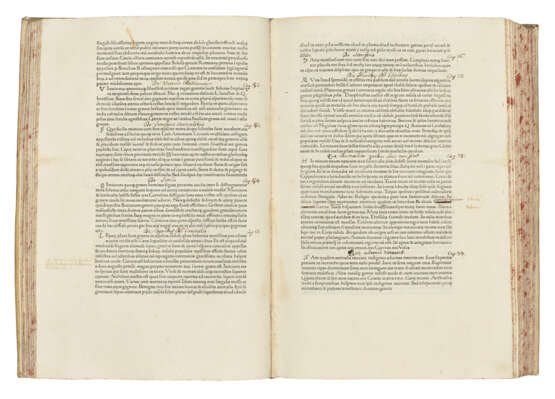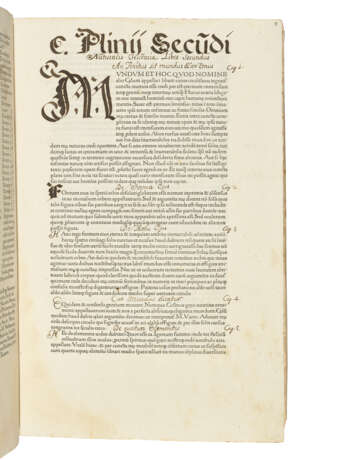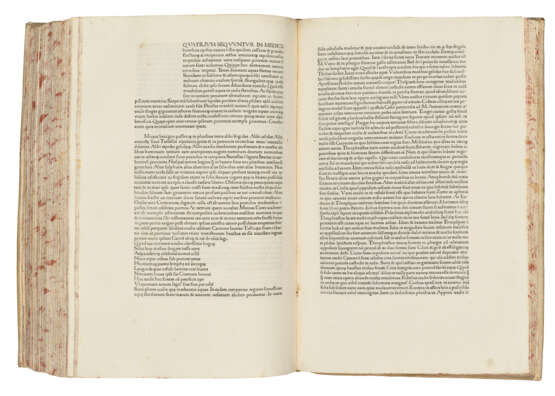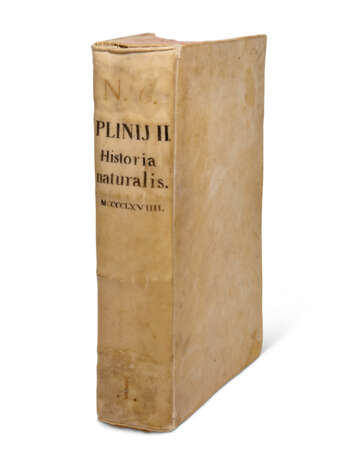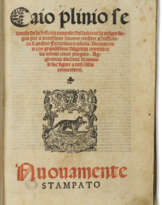ID 1449861
Lot 46 | PLINIUS SECUNDUS, Gaius (Pliny the Elder, 23-79)
Estimate value
£ 400 000 – 600 000
Historia naturalis. Venice: Johannes de Spira, [before 18 September] 1469.
Rare first edition of ‘one of the most influential books ever published’ (Sarton) and one of the first three books printed at Venice. Pliny’s Natural History is an encyclopedia of the known world covering all branches of knowledge. While it is especially devoted to the physical world, such as geography, medicine, engineering, geology, agriculture, sciences, mathematics, pharmacology, etc., the Natural History is also an invaluable source book for art, architecture, crafts and technical processes for metalworking and silversmithing. By his own account Pliny sets out 20,000 facts derived from 2,000 works, which he scrupulously cites, combining fact, myth, personal observation and reported fact. Even up to his death Pliny followed his natural curiosity, preferring to stay and observe the eruption of Vesuvius rather than flee its flames and sulphurous vapours. It is considered the ‘the most important book of science published in the earliest age of printing’ (Rosenwald 92) and ‘one of the great source books of antiquity’ (Stillwell), as well as one of the most influential works ever published.
The Natural History was a standard work of reference, widely read throughout Antiquity and the Middle Ages, and its enduring importance to the Renaissance is further attested by it being one of the first 3 books ever printed at Venice. Johannes de Spira established the first printing press at Venice with a handsome Roman fount, possibly designed by Nicholas Jenson, and in 1469 was granted a 5-year monopoly there. He printed two editions of Cicero’s Epistolae ad familiares and Pliny’s Natural History before his death later that year, having started work on St. Augustine's De civitate Dei. His brother and successor Vindelinus finished that work and stated in its colophon that the Pliny was printed in 100 copies over 3 months; it was finished by 18 September 1469. It remains a rare book, with only one other copy recorded in RBH, last offered a quarter of a century ago at Christie’s in 2000. HC(+Add) 13087; BMC V, 153; CIBN P-457; Klebs 786.1; Bod-inc P-358; PMM 5; Flodr, Plinius Maior 1; Goff P-786; ISTC ip00786000.
Royal folio (394 x 265mm). 355 leaves (of 356, without final blank). 8- to 17-line initial spaces opening each book, smaller initial spaces and spaces for headings and some Greek. Early annotations, including some chapter headings and numbering, notes and corrections, spaces for Greek often filled in early manuscript, 18th-century calligraphic decoration in ink in first 6 quires consisting of major initials (books 1-6) and headings (books 2 and 3), minor ink initials and headings sporadically to quire 17/3, some foliation. Setting of fo.1 line 13 ends ‘apud’ and fo. 5r, col. 1, line 5 reads ‘Vbi nascent[ur]’ as in BL copy IC.19506. (Long, neat tear in 4/10, minor wormhole/track in a few quires usually marginal but more noticeable in final 4 quires, very occasional faint dampstain or small stain, occasional light spotting or browning, ink calligraphy bleeding onto verso.) 18th-century vellum, lettered in ink on spine, red speckled edges. Provenance: occasional annotations in several hands – Mallorca, Capuchin convent (18th-century inscription on first leaf).
| Artist: | Pliny the Elder (23 - 79) |
|---|---|
| Place of origin: | Italy, Europe |
| Auction house category: | Antiquarian books, Medicine & science, Books and manuscripts, Printed books |
| Artist: | Pliny the Elder (23 - 79) |
|---|---|
| Place of origin: | Italy, Europe |
| Auction house category: | Antiquarian books, Medicine & science, Books and manuscripts, Printed books |
| Address of auction |
CHRISTIE'S 8 King Street, St. James's SW1Y 6QT London United Kingdom | |
|---|---|---|
| Preview |
| |
| Phone | +44 (0)20 7839 9060 | |
| Buyer Premium | see on Website | |
| Conditions of purchase | Conditions of purchase |
